The Essential Guide to Creating a Wildflower Bed
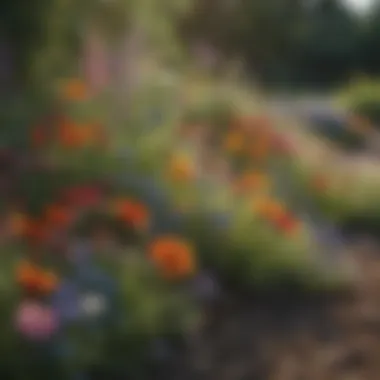
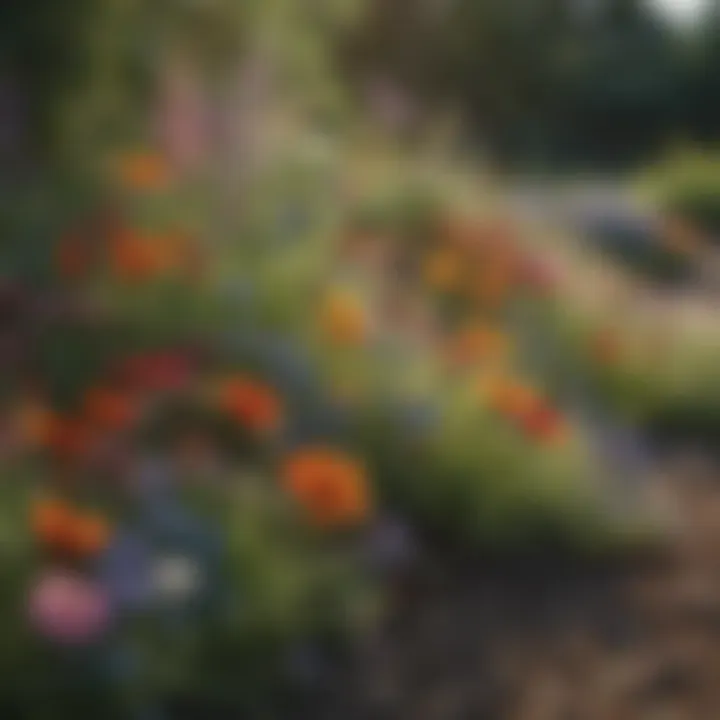
Intro
Creating a wildflower bed can transform any garden into a vibrant haven. This guide will delve into the intricacies of wildflower beds, focussing on designing, selecting the right plants, maintaining the ecosystem, and ensuring aesthetic appeal. Wildflowers can enhance biodiversity, attract beneficial insects, and bring color throughout the seasons. Whether you are a seasoned gardener or just beginning, this guide aims to provide you with practical and impactful insights that will assist in crafting your own wildflower sanctuary.
Design Inspiration
Wildflower beds are not merely patches of flora; they are thoughtful designs that bring together nature’s artistry and ecological function. Incorporating design elements can foster an environment that is both pleasing to the eye and beneficial to the ecosystem.
Current Design Trends
One trend highlights the importance of native species. Using plants that are indigenous to the area not only supports local wildlife but also minimizes the need for maintenance. Another trend is the integration of wildflower beds into existing landscapes. This approach allows blending with established gardens, creating a seamless transition between cultivated and wild spaces.
Color Palettes and Their Effects
When selecting plants for your wildflower bed, consider the emotional impact of colors. Warm colors like reds and yellows can energize and uplift, while cooler colors such as blues and purples can create a calming effect. A balanced palette can foster a dynamic visual experience and can be adjusted according to seasonal changes.
By keeping current trends and color effects in mind, homeowners can create a wildflower bed that is not only beautiful but also supportive of the local ecosystem.
Plant Selection
Choosing the right plants is crucial for a successful wildflower bed. A mix of grasses, flowering plants, and herbs can create a layered effect, attracting a variety of pollinators. Here are some factors to consider:
- Climate: Select plants suited to your local climate. Consider drought-resistant options for warmer regions or moisture-loving plants for cooler areas.
- Soil Type: Understand your soil conditions. Some wildflowers thrive in sandy soil, while others prefer clay. Testing soil pH can also guide your choices.
- Sunlight: Assess how much light your garden receives. Most wildflowers prefer sunny spots, but some tolerate shade.
Keep in mind that diversity is key. A mixture of species will aid resilience and vibrancy.
Tips for Successful Selection
- Research local wildflower options.
- Visit local botanical gardens for inspiration.
- Join gardening clubs for insights from experienced members.
Maintenance
Maintaining your wildflower bed does not have to be overwhelming. Here’s how you can keep it flourishing:
- Weeding: Regular weeding is essential in the early stages of growth. As plants mature, they will naturally suppress many weeds.
- Watering: Watering depends on local rainfall and plant variety. Initially, regular watering helps establish roots.
- Mulching: Applying mulch can prevent weeds and retain moisture. Organic options can decompose, enriching the soil.
Seasonal Care
Adjust your care routine with the seasons. In spring, check for new growth and remove any dead plants. In fall, consider collecting seeds to propagate next year’s display.
The End
Creating a wildflower bed is more than a gardening task; it’s a commitment to enhancing nature and supporting local ecosystems. By crafting a thoughtful design, choosing suitable plants, and maintaining the bed wisely, you can cultivate a vibrant habitat that stands as a testament to nature’s resilience. This guide serves to assist in navigating the complexities of wildflower gardening, ultimately allowing you to enjoy the beauty and benefits of this ecological endeavor.
Prelude to Wildflower Beds
Creating a wildflower bed can transform a simple garden into a sanctuary for wildlife and a tapestry of colors through the seasons. This section will explore the essence of wildflower beds, delving into their unique characteristics and explaining their ecological significance. By understanding wildflowers and their functions, homeowners can appreciate not just the beauty but also the environmental role these plants play.
Understanding Wildflowers
Wildflowers are native plants that grow in the wild without direct human intervention. They are adapted to the local environment, making them resilient and low-maintenance choices for gardeners. Unlike cultivated flowers, wildflowers can naturally thrive in a variety of conditions, from poor soil to variable moisture levels. Understanding these plants involves recognizing their lifecycle, growth habits, and interactions with local fauna. This knowledge can guide the selection of species that will flourish in a specific area, contributing to a healthy ecosystem.
Wildflowers offer a wealth of benefits. They attract pollinators such as bees, butterflies, and birds that are vital for plant reproduction. A rich array of wildflowers can create a habitat that supports numerous other species as well. This interconnectedness is essential for maintaining the diversity of both flora and fauna in our landscapes, fostering a balanced environment.
Importance of Wildflower Beds
Wildflower beds serve multiple purposes beyond mere aesthetic pleasure. They can help improve soil health by preventing erosion and enhancing nutrient cycling. The diverse root systems of wildflowers contribute to soil aeration, which promotes a thriving underground ecosystem.
Moreover, wildflower beds require less water compared to traditional lawns and conventional garden beds.
"Wildflower beds embody a sustainable practice that aligns with ecological principles, making gardening both responsible and rewarding."

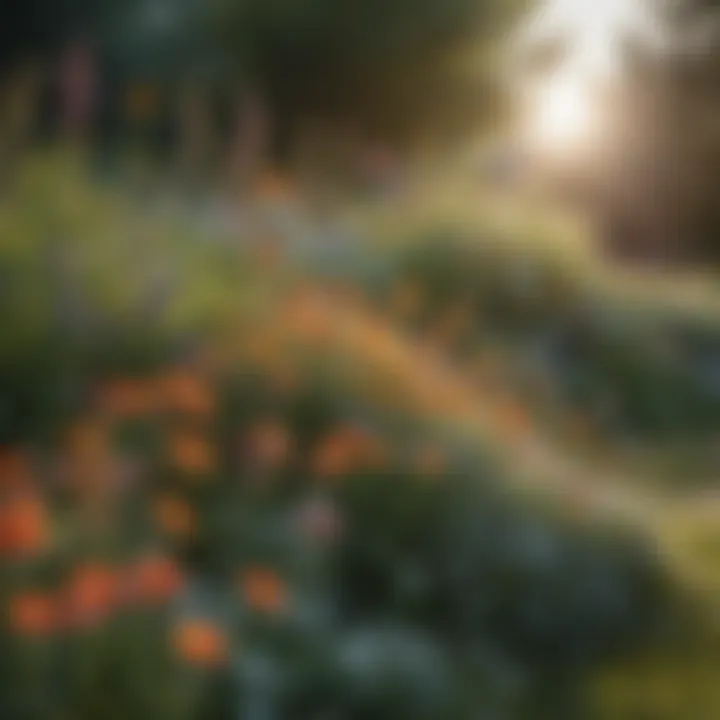
Here are some benefits of having wildflower beds:
- Ecological Support: They provide vital habitats for insects and small mammals, enriching local biodiversity.
- Pollinator Attraction: By attracting bees, butterflies, and other pollinators, wildflower beds contribute to the overall health of the ecosystem.
- Low Maintenance: Once established, wildflowers require minimal care, making them an ideal option for busy homeowners.
- Seasonal Interest: Different species bloom at various times, ensuring that there is always something vibrant and engaging in the garden.
In summary, creating wildflower beds is not just a gardening trend; it is a meaningful commitment to enhancing local biodiversity and supporting environmental sustainability. By harnessing the power of wildflowers, anyone can cultivate a thriving garden that is both beautiful and beneficial.
Selecting the Right Location
Selecting the right location for your wildflower bed is a crucial step in ensuring its success. The location will directly impact the health and vitality of your plants. Factors such as sunlight exposure, soil quality, and drainage need careful consideration.
Choosing a sunny area can maximize flower production. Wildflowers typically thrive with a minimum of six hours of direct sunlight daily. This exposure plays a significant role in photosynthesis, which is the process through which plants convert light into energy. A well-placed wildflower bed can support a biodiverse ecosystem by attracting pollinators like bees and butterflies, which are essential for the reproduction of many flowering plants.
Additionally, understanding your garden's microclimates, such as shaded areas or windy spots, will aid in selecting the ideal site. This knowledge not only influences plant selection but can also enhance the overall aesthetics of your garden.
Sunlight Requirements
Wildflowers generally favor full sun to partial shade. Different species have varying sunlight needs. Therefore, identifying the specific sunlight conditions of your chosen area is essential. For instance, species like Echinacea purpurea (purple coneflower) truly benefit from full sunlight, while others such as Anemone canadensis (Canadian anemone) can tolerate partial shade.
When assessing sunlight, observe the area at different times during the day. Take note of how shadows cast by trees, buildings, or fences change the light availability. Consider these metrics to harmonize plant species with their needs. By planting wildflowers suited for the light exposure of a location, you ensure a more vibrant and healthy garden.
Soil Testing and Preparation
Soil testing is a fundamental aspect of setting up your wildflower bed. It provides valuable insights into soil pH, nutrient levels, and texture, which are vital for plant growth. Well-draining soil typically works best for wildflowers; clay or compacted soils may hinder proper growth.
Conduct a soil test by collecting samples from different spots in the area where you plan to plant. You can send these samples to a local agricultural extension office for analysis or purchase a home testing kit. The results will inform you about necessary amendments. For example, if the pH is too high or too low, you may need to add lime or sulfur accordingly.
Once you understand your soil's composition, preparation begins. Clear the area of any existing vegetation or debris. Add organic matter, like compost, to enrich the soil and improve its structure. This aids in water retention and provides essential nutrients.
In summary, selecting the right location pertains to understanding sunlight needs and conducting thorough soil testing and preparation. By taking these practical steps, you will lay a solid foundation for your wildflower bed, fostering a thriving environment for your selected flora.
Choosing Wildflower Species
Selecting the right wildflower species is a crucial step in creating a successful wildflower bed. It ensures that the plants will thrive in their environment and provides numerous benefits to local ecosystems. This section explores the significance of this choice, focusing on native versus non-native species, seasonal bloom considerations, and companion planting strategies. Understanding these factors will lead to a vibrant and sustainable wildflower bed.
Native vs. Non-native Species
Choosing between native and non-native wildflower species is fundamental to your garden’s health. Native species are adapted to the local climate and soil conditions, requiring less water and maintenance once established. They support local wildlife, including pollinators such as bees and butterflies, which are essential for a balanced ecosystem. Planting native flowers increases biodiversity in your garden, benefiting the wider environment.
On the other hand, non-native species can sometimes offer aesthetic appeal or extended bloom periods. However, they often lack the resilience of native plants and can disrupt local ecosystems. Non-natives may require more water and fertilizers, making them a less sustainable choice. It is essential to weigh these factors carefully before making decisions about which species to plant.
Considerations for Seasonal Blooms
A well-planned wildflower bed should feature a range of species that bloom at different times throughout the growing season. By selecting plants that bloom in spring, summer, and fall, you can ensure continuous color and interest in your garden. This strategy not only enhances the visual appeal but also provides essential habitat and food sources for wildlife year-round.
To achieve this, consider the following:
- Research local wildflower species that bloom throughout the seasons.
- Group plants with similar blooming times to create a more cohesive look.
- Include early bloomers like crocuses and late bloomers such as asters to prolong blooming periods.
By diversifying bloom times, you can create a dynamic environment that supports both plants and wildlife.
Companion Planting Strategies
Companion planting can significantly enhance the growth and aesthetics of wildflower beds. Certain species can benefit from being planted near one another, improving health and resilience while deterring pests. For example, some flowers attract beneficial insects that prey on garden pests.
When selecting companion plants, consider the following points:
- Pest Control: Sunflowers can attract ladybugs, which eat aphids effectively.
- Soil Improvement: Clover can enrich the soil with nitrogen, benefiting nearby plants.
- Aesthetic Enhancement: Mix contrasting colors and shapes for visual impact.
Taking the time to understand these relationships in your wildflower bed will result in a healthier and more vibrant garden.
Choosing the right wildflower species is not merely about aesthetics; it is a profound act of stewardship toward the environment and local ecosystems.
Designing Your Wildflower Bed
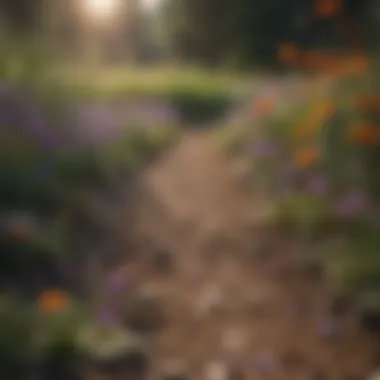

Designing a wildflower bed is an essential element in creating an attractive and functional garden space. A well-designed wildflower bed can not only enhance the aesthetic appeal of your landscape but also foster biodiversity. When planning your wildflower bed, it is vital to consider elements such as layout and color schemes.
Layout Considerations
The layout of your wildflower bed plays a significant role in its overall success. You must determine the shape and size of the bed based on the available space and the desired visual impact. Some common shapes include rectangular, circular, or even freeform designs. When choosing a layout, keep in mind the accessibility. Ensure you can easily reach all areas of the bed for maintenance, including weeding and harvesting if necessary.
Another important factor is the plant heights. Taller plants should be placed towards the back or the center if it is a circular bed. Lower-growing species can be toward the front. This arrangement allows all plants to receive sufficient sunlight and air circulation, preventing overcrowding.
Consider using pathways or stepping stones within your design to facilitate movement. This can effectively break up large areas of flowers and create functional spaces. Additionally, think about seasonal interest. Grouping species by their bloom time can provide continuous color and keep the area engaging throughout different seasons.
Color Schemes and Aesthetics
Color schemes in your wildflower bed should align with the desired mood and theme of your garden. A harmonious palette not only adds visual appeal but also helps in creating an inviting atmosphere. Choose colors that complement one another and consider how they will appear together in various lighting conditions.
For a vibrant and lively garden, opt for bold hues such as yellows, reds, and purples. Alternatively, a more subdued palette of blues, whites, and pinks can evoke tranquility and calmness. Mixing different shades of the same color can also create depth and interest without overwhelming the viewer.
Contemplate seasonality when selecting your color scheme. Choose flowers that will bloom at different times of the year to maintain color throughout the seasons. For instance, plant spring bloomers like Dianthus alongside summer favorites such as Black-eyed Susans to maximize color impact.
In addition, consider using textures. Different plant species have unique leaf shapes and arrangements. Combining plants with varying foliage adds depth and draws the eye across the wildflower bed.
A thoughtfully designed wildflower bed not only apPEALS visually but also serves as a refuge for wildlife, enhancing the ecological value of your space.
In summary, the design of your wildflower bed encompasses several key considerations that impact both its function and beauty. Take the time to thoughtfully plan your layout and color schemes. This effort will ultimately result in a thriving eco-friendly space.
Planting Wildflowers
Planting wildflowers is a crucial step in creating a vibrant and sustainable wildflower bed. This process is not merely about putting seeds in the ground; it involves careful planning and understanding multiple elements that contribute to the success of the wildflower bed. A well-planned planting ensures optimal germination and growth of the species chosen, significantly enhances the ecological benefits, and harmoniously integrates the flora into the surrounding landscape.
Timing and Seasonal Considerations
Timing is essential when planting wildflowers. Each species has its preferred planting season. For example, many native wildflowers thrive when seeded in early spring or late fall. Planting during these times allows seeds to benefit from natural moisture and temperature fluctuations, which stimulate germination.
Also, it’s essential to be aware of local climate patterns. In areas with late frosts, it might be wise to plant after the risk of frost has passed. Consistent temperatures around 70°F (21°C) are optimal for most wildflower seeds. Thus, keeping track of local soil temperatures and weather reports can be beneficial.
Planting Techniques
The method of planting wildflowers also affects their growth. Here are some effective techniques for a successful start:
- Broadcast Seeding: This technique involves scattering seeds over the prepared soil bed. It works best with small seeds and creates a natural look. However, it may require a higher seed rate to ensure good coverage.
- Drill Seeding: For more control over seed spacing and depth, drill seeding can be used. This approach involves using a seed drill to place seeds at a consistent depth, ideal for larger seeds or in cultivated soil. It minimizes seed waste and aids in uniform growth.
- Transplanting Seedlings: Sometimes, starting seeds in pots indoors or in a nursery provides more control. When seedlings are strong enough, they can be carefully transplanted into the wildflower bed. This method is particularly useful for species that need extra care during germination.
Maintenance of Wildflower Beds
Maintaining a wildflower bed is critical to its success and longevity. This section will delve into essential practices that ensure your wildflower bed continues to thrive, providing both beauty and ecological benefits. Proper maintenance not only enhances the aesthetic appeal but also promotes the health of the ecosystem you are supporting.
Watering Practices
Watering is a fundamental aspect of wildflower bed maintenance. Knowing when and how to water can significantly impact the growth and blooming of your wildflowers.
- Frequency: During the initial planting phase, regular watering is crucial. Seedlings may require daily watering, especially in hot weather. Once established, most native wildflowers are drought-tolerant and need less frequent watering.
- Method: Using a soaker hose or drip irrigation can provide consistent moisture without waterlogging the soil. Overhead watering might lead to excess evaporation and fungal diseases.
- Timing: Water early in the morning to minimize evaporation loss. If extreme heat is expected, a deep watering in the evening might be beneficial.
Remember, established plants generally need less frequent watering, allowing for natural rain to take care of their needs.
Weeding and Pest Control
Managing weeds and pests is crucial for a flourishing wildflower bed. Both can easily outcompete your chosen flowers for resources such as nutrients and sunlight.
- Weeding: Regularly inspect your wildflower bed for unwanted plants. Hand-pulling weeds is often effective, especially after watering when the soil is moist. This method prevents disturbing the roots of established wildflowers.
- Natural Pest Control: Encourage beneficial insects like ladybugs and lacewings, which can help keep pests like aphids in check. Planting a variety of wildflowers can attract these helpful insects.
- Monitoring: Keep an eye on changes in your garden. If the population of harmful pests rises significantly, consider applying insecticidal soap or neem oil as a less harmful alternative to chemical pesticides.
Mulching and Fertilization
Applying mulch and fertilizer can provide essential support for your wildflower bed, but it must be executed with care.
- Mulching: A 2-3 inch layer of organic mulch helps retain soil moisture and suppresses weeds. Good materials include shredded bark, straw, or even dried grass clippings. However, be mindful not to cover the crowns of your plants.
- Fertilization: Wildflowers, particularly native varieties, often thrive in low-nutrient soils. In many cases, additional fertilization may not be necessary. If soil tests indicate a nutrient deficiency, consider using organic fertilizers sparingly. This helps maintain ecological balance.
- Timing for Mulch and Fertilizer: The best time to add mulch is in early spring or late fall. Fertilizers, if needed, are best applied in early spring.
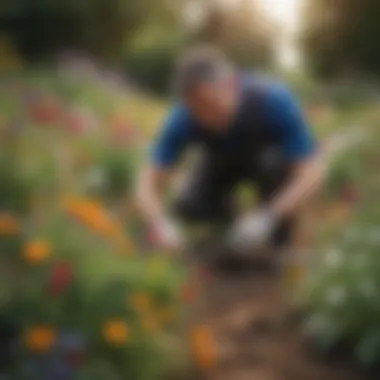
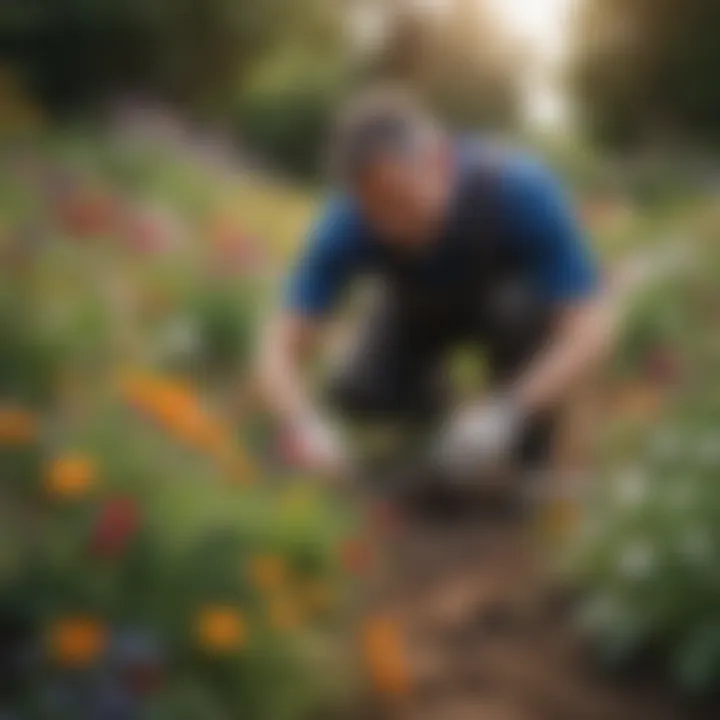
Keeping up with these maintenance practices can determine the vibrancy and longevity of your wildflower bed. Each step enriches not only the visual aspect of your garden but significantly contributes to supporting local wildlife and promoting biodiversity.
Wildflower Bed Challenges
Creating and maintaining a wildflower bed can present various challenges that require careful consideration. These challenges are essential to understand for successful garden management and to maximize the benefits of such a bed. Wildflower beds not only add aesthetic value to a garden but also support local ecosystems and encourage biodiversity. Thus, addressing potential obstacles can significantly enhance the sustainability of your wildflower bed.
Dealing with Invasive Species
Invasive species pose a serious threat to native plants in wildflower beds. They compete aggressively for resources such as sunlight, water, and nutrients. Once established, invasive plants can quickly dominate an area, outcompeting and eventually displacing native wildflowers. This not only reduces biodiversity but can also alter the local ecosystem.
To effectively manage this challenge, consider the following actions:
- Regular Monitoring: Frequently check your wildflower bed for any signs of invasive plants. Early detection is crucial in preventing their spread.
- Manual Removal: Hand-pulling or digging out invasive species, especially before they flower and set seeds, can help control their population. Be sure to carefully dispose of removed plants away from your garden.
- Use Native Plants: Selecting native wildflower species that are well-adapted to your local environment can create a balanced ecosystem that is more resistant to invasives. This biodiversity strengthens the overall health of your wildflower bed.
Research indicates that native plants provide habitat and food sources for local wildlife, furthering their role in the local ecosystem.
Adapting to Climate Changes
Climate change is increasingly affecting gardening practices, including the cultivation of wildflower beds. Fluctuating temperatures, changing precipitation patterns, and unpredictable weather events can pose significant challenges to plant health and sustainability.
To adapt to these shifting conditions, gardeners must consider:
- Water Management: Implementing efficient irrigation methods ensures that wildflowers receive adequate moisture without overuse of water. Consider rain barrels or drip irrigation for efficiency.
- Climate-Resilient Species: Choosing resilient wildflower species that can withstand extreme weather conditions is vital. Research which plants are most suited to your region's changing climate and prioritize them in your selections.
- Soil Health: Maintaining healthy soil can enhance the resilience of your wildflower bed. Regularly amend the soil with organic matter to improve its structure and water retention capabilities.
As you plan your wildflower garden, recognizing these challenges as part of the process can foster a more robust and thriving ecosystem. Engaging actively with these issues ensures that your wildflower bed not only survives but thrives in harmony with nature.
Educational Resources
Understanding wildflower beds can be a complex journey, but educational resources play a vital role in shaping this experience. This section serves as a gateway to various tools and information that assist in the planning, planting, and maintenance of wildflower beds. By leveraging these resources, gardeners gain a deeper understanding of the native flora, local ecosystems, and effective gardening techniques. These insights not only make the process more manageable but also enrich the overall gardening experience.
Books and Guides
Books and guides are essential references for anyone looking to create a wildflower bed. They provide detailed information about plant species, soil types, and maintenance practices. A well-curated selection can help clarify misconceptions and guide gardeners through the nuances of wildflower cultivation.
Some recommended titles include:
- Bringing Nature Home by Douglas W. Tallamy
- The Wildflower Gardener's Bible by M. E. Morris
- Field Guide to the Birds of North America by National Geographic
Each of these books includes practical tips and rich illustrations, making them valuable for visual learners. They can serve both novice and experienced gardeners, shedding light on local biodiversity and sustainable gardening practices.
Online Tools and Communities
The internet has transformed how gardeners access information. Online tools and communities offer a wealth of resources that can enhance the wildflower bed creation process. Websites such as Wikipedia and Britannica provide foundational knowledge, while forums on Reddit and groups on Facebook facilitate exchanges between gardening enthusiasts.
Some useful online tools include:
- Plant hardiness zone maps
- Native plant databases
- Gardening blogs with personal experiences
Engaging with online communities allows gardeners to share insights, ask questions, and receive feedback. This dialogue can help identify challenges and celebrate successes in creating wildflower beds. By connecting with a broader community, individuals can enrich their understanding and often discover innovative techniques that they might not encounter in traditional literature.
In summary, leveraging educational resources—be it through books or online platforms—enables effective wildflower bed creation. These tools cultivate knowledge, support sustainable gardening, and promote ecological stewardship.
Culmination
The conclusion acts as a critical capstone for the exploration of wildflower beds, summarizing the numerous benefits and essential considerations discussed throughout this guide. It reinforces the pivotal role that wildflower beds can play not only in enhancing the aesthetic of one’s garden but also in bolstering local ecosystems. Understanding these elements helps homeowners appreciate the diverse flora while achieving a more sustainable gardening practice.
Reflecting on the Benefits of Wildflower Beds
Wildflower beds offer a plethora of ecological and aesthetic advantages that make them a vital addition to any garden. One significant benefit is their ability to attract pollinators, which are essential for the health of many plant species and the overall ecosystem. Butterflies, bees, and other pollinators contribute to the pollination process, supporting food production and biodiversity.
Moreover, wildflowers are remarkably low-maintenance once established. They often require less water and fewer fertilizers compared to traditional gardens filled with non-native plants. This adaptability makes wildflower beds a sustainable choice for gardeners looking to reduce their environmental impact.
In addition to the ecological benefits, wildflower beds enrich the landscape visually. The diversity in color, shape, and texture offers joyful viewing from early spring through late fall. Homeowners can also enjoy the changing scenery each season, creating a dynamic and engaging outdoor space. In summary, the benefits include improved pollinator habitat, lower resource requirements, and enhanced visual appeal.
Encouraging Biodiversity and Environmental Awareness
Wildflower beds significantly encourage biodiversity by supporting various species of flora and fauna. By choosing native plant species, gardeners can create habitats that support local wildlife. This approach is increasingly important in an era where many ecosystems are under threat from urbanization and climate change.
Gardening with wildflowers instills a sense of environmental awareness and responsibility. Homeowners engaged in this practice often become more knowledgeable about the ecosystems around them, fostering a deeper connection to nature. This awareness can extend beyond the garden, leading to advocacy for local conservation efforts.















